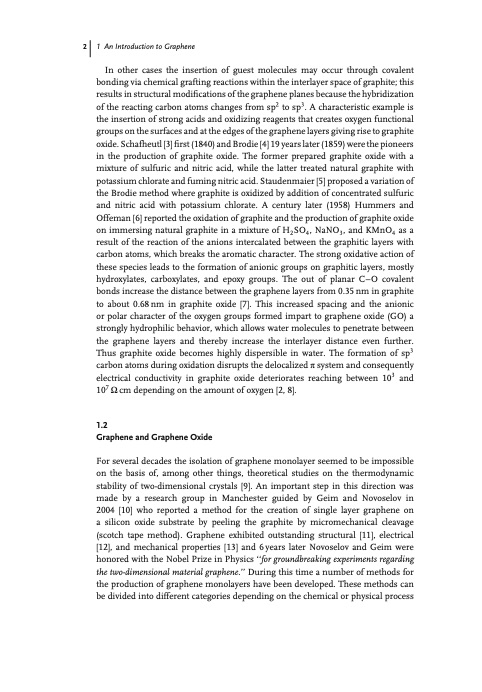
PDF Publication Title:
Text from PDF Page: 002
2 1 An Introduction to Graphene In other cases the insertion of guest molecules may occur through covalent bonding via chemical grafting reactions within the interlayer space of graphite; this results in structural modifications of the graphene planes because the hybridization of the reacting carbon atoms changes from sp2 to sp3. A characteristic example is the insertion of strong acids and oxidizing reagents that creates oxygen functional groups on the surfaces and at the edges of the graphene layers giving rise to graphite oxide. Schafheutl [3] first (1840) and Brodie [4] 19 years later (1859) were the pioneers in the production of graphite oxide. The former prepared graphite oxide with a mixture of sulfuric and nitric acid, while the latter treated natural graphite with potassium chlorate and fuming nitric acid. Staudenmaier [5] proposed a variation of the Brodie method where graphite is oxidized by addition of concentrated sulfuric and nitric acid with potassium chlorate. A century later (1958) Hummers and Offeman [6] reported the oxidation of graphite and the production of graphite oxide on immersing natural graphite in a mixture of H2SO4, NaNO3, and KMnO4 as a result of the reaction of the anions intercalated between the graphitic layers with carbon atoms, which breaks the aromatic character. The strong oxidative action of these species leads to the formation of anionic groups on graphitic layers, mostly hydroxylates, carboxylates, and epoxy groups. The out of planar C–O covalent bonds increase the distance between the graphene layers from 0.35 nm in graphite to about 0.68nm in graphite oxide [7]. This increased spacing and the anionic or polar character of the oxygen groups formed impart to graphene oxide (GO) a strongly hydrophilic behavior, which allows water molecules to penetrate between the graphene layers and thereby increase the interlayer distance even further. Thus graphite oxide becomes highly dispersible in water. The formation of sp3 carbon atoms during oxidation disrupts the delocalized π system and consequently electrical conductivity in graphite oxide deteriorates reaching between 103 and 107 Ω cm depending on the amount of oxygen [2, 8]. 1.2 Graphene and Graphene Oxide For several decades the isolation of graphene monolayer seemed to be impossible on the basis of, among other things, theoretical studies on the thermodynamic stability of two-dimensional crystals [9]. An important step in this direction was made by a research group in Manchester guided by Geim and Novoselov in 2004 [10] who reported a method for the creation of single layer graphene on a silicon oxide substrate by peeling the graphite by micromechanical cleavage (scotch tape method). Graphene exhibited outstanding structural [11], electrical [12], and mechanical properties [13] and 6 years later Novoselov and Geim were honored with the Nobel Prize in Physics ‘‘for groundbreaking experiments regarding the two-dimensional material graphene.’’ During this time a number of methods for the production of graphene monolayers have been developed. These methods can be divided into different categories depending on the chemical or physical processPDF Image | An Introduction to Graphene

PDF Search Title:
An Introduction to GrapheneOriginal File Name Searched:
352733551X-c01.pdfDIY PDF Search: Google It | Yahoo | Bing
Salgenx Redox Flow Battery Technology: Power up your energy storage game with Salgenx Salt Water Battery. With its advanced technology, the flow battery provides reliable, scalable, and sustainable energy storage for utility-scale projects. Upgrade to a Salgenx flow battery today and take control of your energy future.
| CONTACT TEL: 608-238-6001 Email: greg@infinityturbine.com | RSS | AMP |